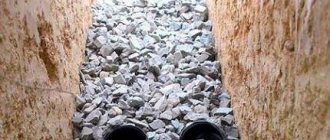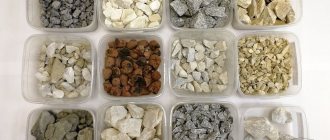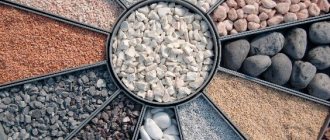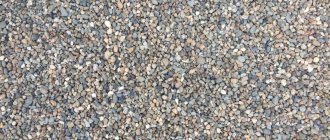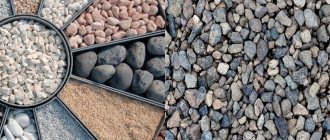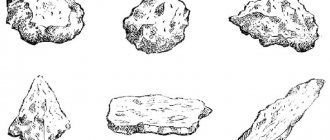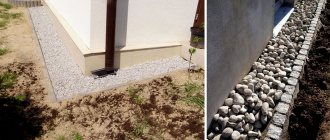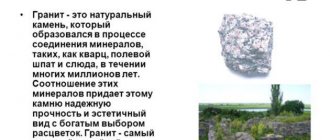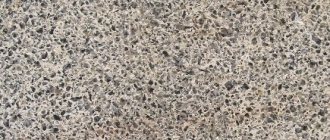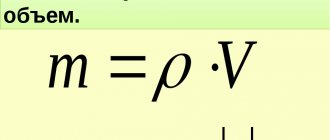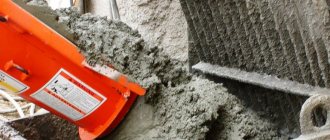Related Articles
Interesting facts about types of timber
20.05.2020
Who produces PVA glue in Belarus?
04.05.2020
Is it worth building a house from sand-lime brick - expert opinion
19.02.2020
Where does construction waste go? Often they are recycled, this applies to waste in the form of asphalt, brick or concrete residues. Recycled crushed stone, which comes to the aid of builders, is much cheaper than granite and allows saving money, which is important for any construction of buildings.
Where can you use recycled crushed stone?
Recycled construction waste has increased strength properties, which allows you to increase the area of its use. The secondary option can become a full replacement for 60% of all crushed stone volumes. The areas of its application are:
- It is used as a concrete filler and is relevant in reinforced concrete structures.
- This is an excellent soil hardener. In places where weak and mobile soil predominates, such crushed stone is irreplaceable.
- When constructing road embankments, GOST allows the use of recycled crushed stone as a backfill for communication structures.
- He became a good assistant in drainage work - for constructing foundations and strengthening pits.
- It is advantageous to lay floors in industrial premises using recycled crushed stone products.
- Looks good as decorative elements of gardens, personal plots, lawns.
Stages of secondary crushed stone production
After the demolition of buildings and other reinforced concrete structures, as well as the dismantling of roads, pieces of brick, concrete and asphalt of different grades remain. They are taken to the crushing shop for processing.
The production of secondary crushed stone takes place in several stages:
- Demolition and dismantling of buildings using a special bucket, excavator and hydraulic shears. The result is concrete pieces ranging in size from 0.5 m to 2.5 m.
- The waste is loaded into dump trucks and taken to the production site for processing.
- The slabs are crushed using a concrete breaker into smaller pieces with a diameter of up to 100 cm using hydraulic shears or a hydraulic hammer.
- The processed material is loaded into special crushing equipment, which crushes it into crushed stone of fraction 0-100.
- The resulting material is cleaned of metal, glass and other inclusions. Metal elements are removed using an electromagnet (separator).
- At the last stage, the building materials are sorted into 4 fractions - 5x20, 5x40, 20x40, 40x70 and screening. For this purpose, a special sieve is used - a screen. Each of these fractions is intended for a specific type of work.
The final stage need not be carried out, since the resulting secondary crushed stone can already be used for laying the foundation or filling building structures. To prepare the necessary raw materials, it is enough to remove metal debris. This method of extracting material reduces the cost of building a building and increases the speed of production.
Are there any disadvantages to recycled crushed stone?
Any good undertaking cannot do without a fly in the ointment. Recycled crushed stone sometimes has low strength compared to the granite type. Although GOST allows the use of reinforced concrete products for filling, and they do not fail in most cases.
The main disadvantage was the insufficient ability to withstand severe frosts. Therefore, it is necessary to limit its operating area. In particular, during the construction of road routes and highways, there is no need to talk about the inclusion of recycled material in the construction if a large load is expected. But as a “consumable” for pedestrian paths and backfilling of country roads, it is quite suitable.
Today, the use of this type of material is a good option from an environmental point of view, since it is harmless. With skillful use and knowledge of its features, you can win with it and save the “lion’s share” of finances.
Recycled crushed stone: concrete look
The presented material is isolated as a separate group. This phenomenon is quite justified. As a result of building demolition, we end up with a lot of concrete and reinforced concrete structures, which are often sent to landfill.
75% of the waste resulting from demolition of buildings is quite suitable for reuse. Thus, concrete can be recycled and used for the construction of a new building on the site of the same old one.
Among construction organizations, one can often identify the following pattern: they create their own production complexes. After the destruction of a building, organizations do not get rid of garbage, but send it for recycling. A hydraulic hammer and hydraulic shears, which are special attachments that are attached to an excavator, help crush concrete structures. This complex also allows you to immediately extract metal particles. The crushing hopper is equipped with large magnets (separators) that help pull out metal inclusions and remnants of reinforcement.
50-60% of the crushed stone used for construction can be replaced with recycled material, since it is suitable for filling concrete mortars and pouring foundations. If you close construction production and establish recycling, you can get an endless stream of high-quality raw materials.
Basic properties of secondary crushed stone
Recycled concrete crushed stone
Recycled crushed stone has many significant characteristics:
- Flakiness, which determines the flatness of the material, since crushed stone can be needle-like or plate-like, and the higher this parameter, the higher quality the material is considered, and this is due to the fact that the use of flat elements guarantees dense compaction of the layers.
- Radioactivity represented by classes I and II. GOST states that in class I the amount of radionuclides is about 370 Bq/kg, and such secondary crushed stone is used for numerous areas of construction. Class II material contains radionuclides in an amount of 740 Bq/kg. Its main purpose is considered to be use in the process of road construction.
- Frost resistance. It is designated by the letter F. The higher this indicator, the more specific operating conditions the material can be used.
- Strength. When purchasing crushed stone, you should take into account this indicator, designated by the letter M. It should be high, since resistance to various mechanical influences and service life depend on it.
Thus, recycled crushed stone has specific characteristics that are certainly taken into account in the process of its selection and acquisition.
Important! When choosing, the basic information contained in GOST is taken into account in order to obtain products that are safe for use. Recycled material can be made from a variety of raw materials. Granite crushed stone is considered especially popular for this. Can be used in decorative works or as an additive during various construction works. Granite crushed stone has a good indicator of strength and flakiness. Limestone material contains large amounts of calcium carbonate. Used in road works or reinforced concrete construction. Crushed slag has a low cost due to its ease of production, but its strength is not considered too high.
Recycled granite crushed stone
Thus, according to GOST, the production of recycled material can be carried out using different raw materials. Depending on the components, its parameters are determined.
CRUSHED STONE IS EDUCATION FOR DUMMIES. Part 1 (types of building crushed stone)
It is probably not an exaggeration to say that crushed stone is the most popular of the hard, dense rocky materials in the construction of various types of buildings and structures.
Crushed stone is used as a filler for concrete and as drainage in a variety of places; it is used in the construction of roads and laying railway tracks, in arranging various landscape design objects, etc. They even paint it, then creating multi-colored bright panels from colored pebbles.
However, despite this prevalence, quite a lot of people do not know what kind of building material is hidden behind the name crushed stone and how it differs from gravel, with which it is often confused.
HOW TO DISTINGUISH FROM GRAVEL
Let's start with the basic definition: crushed stone is a bulk material that is obtained by crushing natural or artificial stone materials. This means that the main characteristic of crushed stone is the geometric shape of individual pebbles. That is, if you see a bunch of hard pebbles with sharp edges, then it will be crushed stone, regardless of color and origin.
Gravel is formed as a result of natural weathering processes (sifting) of solid rock. Therefore, its individual stones are rounded, that is, they have a round shape without sharp corners, unlike crushed crushed stone.
Such a difference in the shape of individual pebbles (grains) also determines the difference in their adhesion to a mixture of cement and sand during concrete production. Crushed stone, due to its uneven sharp edges and rough surface, has higher adhesion and the resulting concrete will be stronger than if gravel is used as a filler.
It was already mentioned above that crushed stone is, in fact, a form of individual pebbles. As for the “content”, that is, the properties of the material itself, they can vary within fairly wide limits.
So, if crushed stone was obtained from natural stone, then it can be either igneous (granite, gabbro, basalt, etc.), metamorphic (gneisses, eclogites, marble, etc.) and sedimentary (limestones, dolomites) rocks.
In addition, crushed stone can be obtained in the process of crushing a variety of solid waste that appears after construction work or during the production of ceramics, and even slag and slag alloys from various metallurgical enterprises (blast furnace, steel smelting plants, etc.).
MAIN TYPES OF CRUSHED STONE FOR CONSTRUCTION
In construction work, in the vast majority of cases, three types of natural crushed stone are used: granite, gravel and limestone. The most common crushed stone made from artificial stone materials is secondary.
Granite crushed stone is produced by explosion and subsequent crushing of granite layers. Of the three indicated types, it is the most expensive, which is due to its greatest resistance to loads and adverse environmental influences.
It is used mainly for producing especially hard concrete, when pouring building foundations, constructing bridges, highways, etc.
Crushed gravel is the result of crushing gravel from a sand-gravel mixture mined in a quarry or from the bottom of a reservoir. Its properties are inferior to granite, but its cost is also lower.
Moreover, if gravel from mountain rock was mined in a quarry (the so-called gully gravel), then the surface of its grains is rougher than that of pebbles from the bottom of reservoirs (sea or river gravel). Therefore, adhesion to the sand-cement mixture, and, accordingly, the strength of concrete, will be higher with crushed stone from ravine gravel.
In individual suburban construction, the use of crushed gravel is most optimal, unless, of course, you are building an underground bunker in case of the use of nuclear weapons.
We also recommend: ASSEMBLY FENCE – FAST, SIMPLE and RELIABLE
Crushed limestone is produced by crushing limestone. Being sedimentary rocks, limestones have the least strength, which determines the lower cost of such crushed stone.
It is intended for so-called non-critical construction: low-rise buildings, roads with light loads, production of reinforced concrete structures: trays and rings, etc.
If you plan to use such crushed stone to fill the foundation, you must take into account that limestone is mainly calcium carbonate, which, although quite slowly, dissolves with water.
It is due to this that beautiful compositions of stalactites and stalagmites are formed in caves, and karst funnels appear in limestone rocks.
If carbon dioxide is present in the water, the dissolution process occurs much faster. This gas is released as a result of the reaction of calcium carbonate with acids. Therefore, in the vicinity of groundwater with high acidity (if its pH is below 6.0), it is better to give preference to more resistant crushed stone, since in the future this can significantly affect the durability of the foundation of the building.
Secondary crushed stone is the result of crushing concrete, brick, aerated concrete, etc. to be recycled. Most often, sellers offer recycled crushed concrete. It has a lower cost than natural ones, but when buying such material you are essentially buying a pig in a poke.
After all, even if granite crushed stone was used as a filler, there is no guarantee at all that the cement was of the proper quality and that all technological standards were observed in the production of concrete and that it meets the declared strength.
If you are planning to use such secondary crushed stone in critical places of the structure or buildings being erected (for example, for pouring a foundation), then to guarantee quality, you can make test cubes of new concrete with it and send it to the laboratory to determine the strength.
You can check the strength of the resulting concrete yourself using the impact pulse method, using either a special Kashkarov hammer or improvised means.
All these methods are based on assessing the imprint of an impact on the concrete surface. Only in the first case, the impact assessment is carried out relative to a special standard, and in the rest - “by eye”, which affects the accuracy. With the means at hand, the result will be rather approximate, but for private construction it is quite acceptable.
One of the available methods is to use a hammer with a working metal blank weight of 400 - 500 grams and a chisel. If, after the impact, the chisel entered the concrete 1 cm or more, then its grade is no higher than M75, if it plunged no deeper than 0.5 cm - M100 - M150, if there is a small dent with small pieces breaking off - no less than M200, and if there is no damage visible - M350.
Another similar method is a medium-force blow on a concrete workpiece with a mechanic’s hammer with a convex spherical striker. If after this a dent 1 mm deep remains on the surface, then the concrete grade is M50 - M75, if it is less deep - M75 - M100, and if there is no dent left at all - M150 - M200.
In the following parts of the educational program, the main characteristics of crushed stone will be considered, which determine the scope of its application and are determined both by the geometric parameters of the grains (fractions, flakiness) and the physical properties of the material itself (strength, frost resistance, radioactivity).
Share information - don't leave your friends in the dark: Facebook
VK
Tumblr
StumbleUpon
Buffer
